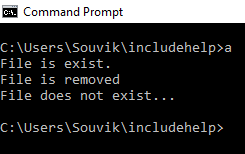c語言 函數的參數傳遞示例
C語言中的remove()函數 (remove() function in C)
The remove() function is defined in the <stdio.h> header file.
remove()函數在<stdio.h>頭文件中定義。
Prototype:
原型:
int remove(const char* filename);
Parameters: const char *filename
參數: const char *文件名
Return type: int
返回類型: int
Use of function:
使用功能:
When we are dealing with files then sometimes we need to erase or delete some files. In file handling, we use remove() function to erase the files. The prototype of the function remove() is int remove(const char* filename);
當我們處理文件時,有時我們需要擦除或刪除一些文件。 在文件處理中,我們使用remove()函數擦除文件。 函數remove()的原型是int remove(const char * filename);
Here, filename is the name of the file which has to be erased. It returns zero if the file is successfully deleted and non zero if an error occurred.
在這里, 文件名是必須刪除的文件的名稱。 如果成功刪除了文件,則返回零;如果發生錯誤,則返回非零。
C語言中的remove()示例 (remove() example in C)
#include <stdio.h>
#include <stdlib.h>
int main(){
FILE *f;
//Check the existence of that file
if((f=fopen("includehelp.txt","r"))==NULL){
printf("File does not exist...\n");
}
else{
printf("File is exist.\n");
}
fclose(f);
//remove file
if(remove("includehelp.txt"))
printf("Remove error.....\n");
else
printf("File is removed\n");
//Check the existence of that file
if((f=fopen("includehelp.txt","r"))==NULL){
printf("File does not exist...\n");
}
else{
printf("File is exist.\n");
}
fclose(f);
return 0;
}
Output
輸出量

翻譯自: https://www.includehelp.com/c-programs/remove-function-in-c-language-with-example.aspx
c語言 函數的參數傳遞示例
)


商學院徒步戈壁挑戰賽,賦詞幾首)
方法與示例)



方法與示例)



方法(帶示例))
)

方法與示例)

)

方法與示例)